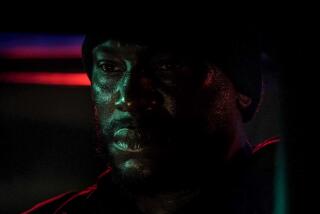TV REVIEW : Smoldering Hatreds in âHoward Beachâ Movie
If the murder rate in the United States were as large as the percentage of television time given murder, thereâd be no one alive to watch television.
At least NBCâs âHoward Beach: Making the Case for Murderâ--9 tonight on Channels 4, 36 and 39--brings something to the table beyond gratuitous bloodshed. Speaking with a sort of ugly eloquence, itâs a crisp, sober account of a headline-making crime case that inflamed racial tensions.
The violence here--and it is brutal and vicious--is merely a symptom, the hacking smokerâs cough telling you that something deep inside is rotting. Itâs also the framework and explosive context for this movie, a visible manifestation of the pockets of smoldering hatreds that underlie and burn away at America.
The case begins on the night of Dec. 20, 1986.
A car with three black men breaks down in the essentially white community of Howard Beach in Queens, N.Y. As in the darkest days of the old South, the blacks are confronted, taunted, harassed and chased by a group of white teens. Timothy Grimes (Anthony Russell Jr.) escapes. Cedric Sandiford (Joe Morton) is severely beaten. Sandifordâs stepson, Michael Griffith (Cleodis Ingram), flees from his attackers onto the busy Belt Parkway, where he is hit by a car and killed.
With this night of terror as a catalyst, Steve Bellowâs script proceeds to relate the Howard Beach case and its racially tense environment from the perspective of Joe Hynes (Daniel J. Travanti), the able New York State special prosecutor who triumphs here despite nagging political pressures and being haunted by the memory of a previous case that he lost.
The cast is strong. Travanti is especially solid, as is Morton as the determined Sandiford, who rebounds from his terrible beating to star in the courtroom. And William Daniels is his snide best as shrewdly manipulative defense attorney David Slaney.
A slave to its stopwatch, television has a way of abridging experiences and skipping over the middle chapters right to the thundering conclusion. Hence, rarely do TV portrayals of crime cases portray the tortuous process--the seemingly menial grunt work and the frustrations, false starts and dead ends--of preparing for the courtroom.
âHoward Beachâ is the happy exception. Directed with pace and precision by Dick Lowry, these taut scenes of Hynes and his legal team methodically constructing a case for the grand jury, and later for trial, are just fascinating.
Where âHoward Beachâ falls down in some respects is in the courtroom. The trial depiction is suspenseful and punctuated by sharp dramatic twists, but also so truncated that chunks of critical testimony appear to have been abandoned to the cutting room floor.
Of course trials must be abbreviated for TV, but this goes too far. For example, the prosecution team is shocked to learn during the course of the trial that one of the surviving victims, Grimes, had 10 times as much cocaine in his system as was previously reported. âSlaney will have a field day with that,â predicts one Hynes associates. âTell me about it,â Hynes agrees glumly.
But the revelation never surfaces in court. Nor does one of the white assailants who makes a deal to testify against his comrades.
âHoward Beachâ is still an intriguing two hours, however, and just as important, a jolting look at the worst of ourselves.
More to Read
The complete guide to home viewing
Get Screen Gab for everything about the TV shows and streaming movies everyoneâs talking about.
You may occasionally receive promotional content from the Los Angeles Times.






